
Nobile is a lunar impact crater that is located near the southern pole of the Moon. It was named after the Italian aviator and explorer Umberto Nobile by the International Astronomical Union (IAU) in 1994. It lies to the south of the crater Scott, along the western rim of Amundsen. Between Nobile and the southern pole lie the smaller craters Shoemaker and Faustini.

Mons Hadley is a massif in the northern portion of the Montes Apenninus, a range in the northern hemisphere of the Moon. It has a height of 4.5 km (2.8 mi) 14,764 ft (4,500 m) above the adjacent plain and a maximum diameter of 25 km at the base.
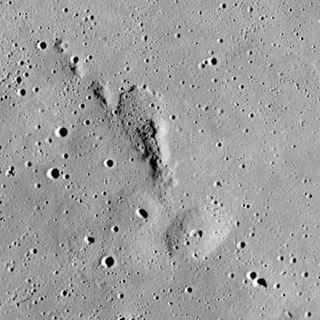
Mons Esam is a small, isolated mountain in the northern part of the Mare Tranquillitatis. It is located to the southeast of the crater Vitruvius and to the west-northwest of Lyell. To the northeast of this ridge is the bay called Sinus Amoris.

Mons La Hire is a solitary lunar mountain in the western Mare Imbrium. It is located to the northeast of the crater Euler, and to the west-northwest of Lambert.

Mons Vinogradov is a rugged massif that is located on the lunar mare where Oceanus Procellarum to the southwest joins Mare Imbrium to the east. There are three primary peaks in this formation, which rise to altitudes of 1.0–1.4 km above the surface. To the east of this rise is the crater Euler, and to the southeast is an area of rugged ground that reaches the Montes Carpatus range. The Carpatus mountain range forms the southwest boundary of the Mare Imbrium.

Mons Bradley is a lunar mountain massif in the Montes Apenninus range, along the eastern edge of the Mare Imbrium. It is located to the west of the crater Conon. To the west of this peak is the Rima Bradley rille.
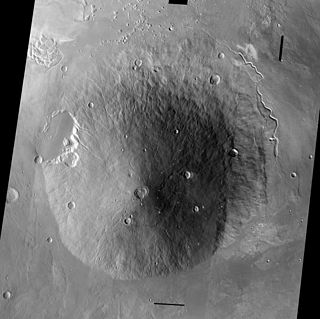
Hecates Tholus is a Martian volcano, notable for results from the European Space Agency's Mars Express mission which indicate a major eruption took place 350 million years ago. The eruption created a caldera 10 km in diameter on the volcano's western flank.

Mons Hadley Delta (δ) is a massif in the northern portion of the Montes Apenninus, a range in the northern hemisphere of the Moon adjacent to Mare Imbrium. It has a height of 3.6 km above the plains to the north and west.

Mons Agnes is a hill ("mountain") on the Moon, in Lacus Felicitatis, inside the crater-like feature Ina, at 18.66°N 5.34°E. It has a maximal width of approximately 650 m. Its height is more difficult to determine; from Apollo 15 images it was determined as about 30 m, but a newer map, based on LRO photos, gives about 10 m.

Estan Patera is a patera, or a complex crater with scalloped edges, on Jupiter's moon Io. It is 95 kilometers in diameter and located at 21.53°N 87.59°W. It is named after the Hittite sun god Estan. Its name was adopted by the International Astronomical Union in 2006. It is located at the northern base of the 11-kilometer mountain Gish Bar Mons. Located west-northwest is Skythia Mons, and to the southwest is Monan Mons, at the northern and southern ends of which are Monan Patera and Ah Peku Patera.

Pyerun Patera is a patera, or a complex crater with scalloped edges, on Jupiter's moon Io. It is about 57 kilometers in diameter and is located at 55.65°S 251.06°W. It is named after the Slavonic god of thunder, Pyerun. The name was adopted by the International Astronomical Union in 1985. West of Pyerun Patera is Mithra Patera, and to the east is the mesa Epaphus Mensa. To the northeast is Epaphus Mensa, and to the northwest are the mountain Silpium Mons and Svarog Patera.

Egypt Mons is a mountain on Jupiter's moon Io. It is 10 kilometers in height, making it the 11th tallest mountain on Io, and taller than Mount Everest. Although the U.S. Geological Survey gives a diameter of 193.7 kilometers, the Io Mountain Database gives a length of 133.8 kilometers and a width of 146.0 kilometers. It is a Flatiron Massif mountain, meaning it has a rugged, irregular appearance and complex surface morphology. It is 9792 km2 in area and its center located at 41.49°S 257.6°W. It has a steep, north-facing scarp. Egypt Mons is named for Egypt, because that is the place where Io ended her wanderings in the mythology. Its name was adopted by the International Astronomical Union in 1997. To the northwest is Babbar Patera, and southeast is Hermes Mensa. Svarog Patera can be found to the southwest.

Silpium Mons is a mountain on Jupiter's moon Io. It is 5.6 kilometers in height, 113 kilometers in length, and 79.7 kilometers in width. It covers an area of 7073 km2. It is a striated ridge, meaning it is an elevated structure dominated by one or more prominent linear or arcuate rises. It is named after a location in Greece where the mythological Io died of grief. Its name was adopted by the International Astronomical Union in 1979. It is located at 52.71°S 272.34°W, south of Svarog Patera, north of Mithra Patera, and northeast of Viracocha Patera. Its proximity to Svarog and Viracocha Paterae has been suggested to be evidence for a structural relationship between mountains and calderas on Io.

Apollinaris Mons is an ancient shield volcano in the southern hemisphere of Mars. It is situated near the equator, south of Elysium Planitia and north of the impact crater Gusev. Elysium Planitia separates it from the volcanic province of Elysium to its northwest. The volcano's caldera is named Apollinaris Patera; this name formerly applied to the whole edifice.
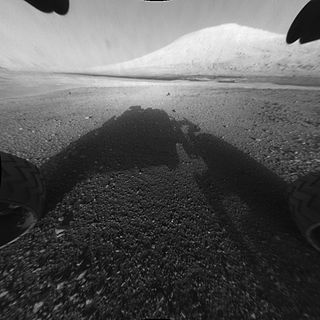
Mount Sharp, officially Aeolis Mons, is a mountain on Mars. It forms the central peak within Gale crater and is located around 5.08°S 137.85°E, rising 5.5 km (18,000 ft) high from the valley floor. Its ID in the United States Geological Survey's Gazetteer of Planetary Nomenclature is 15000.
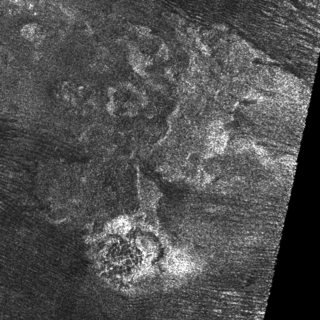
Doom Mons is the name of a mountain range and its eponymous peak on Titan, the largest moon of Saturn. A putative cryovolcano, it is the largest mountain range on Titan by volume, and at 4,757 ft (1,450 m) one of the highest in the Solar System. It was discovered by the Cassini–Huygens probe in 2005 and officially named in 2012.
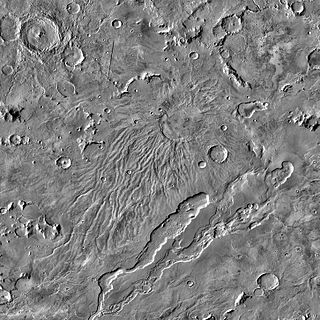
Hadriacus Mons is an ancient, low-relief volcanic mountain on the planet Mars, located in the southern hemisphere just northeast of the impact basin Hellas and southwest of the similar volcano Tyrrhenus Mons. Hadriacus Mons is in the Hellas quadrangle. It has a diameter of 450 kilometres (280 mi). The name was approved in 2007. The flanks of Hadriacus Mons have been eroded into gullies; its southern slopes are incised by the outflow channel Dao Vallis. The large extent of volcanic deposits and the caldera size leads some researchers to suggest that these features were the result of an explosive event caused by a contact between magma and groundwater.

Melba Roy Mouton was an American mathematician who served as Assistant Chief of Research Programs at NASA's Trajectory and Geodynamics Division in the 1960s and headed a group of NASA mathematicians called "computers". She served as Head Mathematician for Echo Satellites 1 and 2 before becoming Head Computer Programmer and then Program Production Section Chief at Goddard Space Flight Center.

VIPER is a lunar rover developed by NASA, and currently planned to be delivered to the surface of the Moon in November 2024. The rover will be tasked with prospecting for lunar resources in permanently shadowed areas in the lunar south pole region, especially by mapping the distribution and concentration of water ice. The mission builds on a previous NASA rover concept called Resource Prospector, which was cancelled in 2018.


















